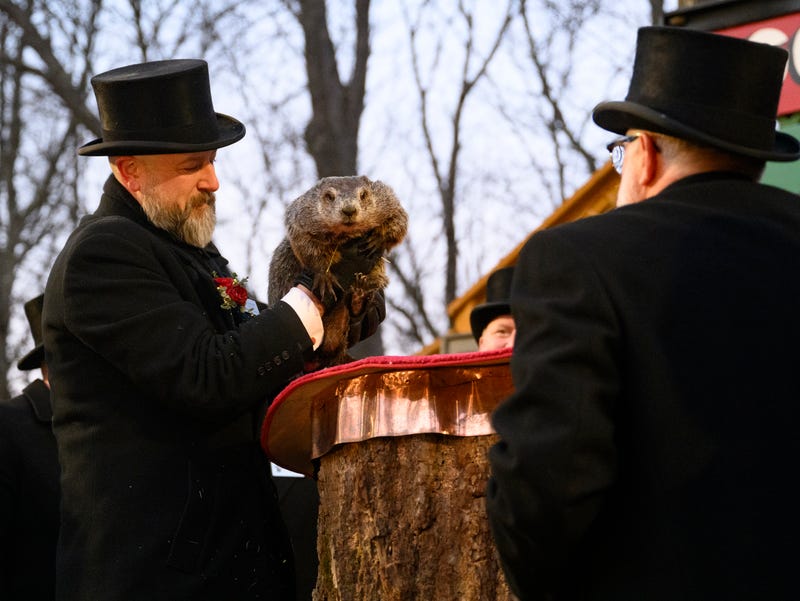
HOWELL (WWJ) Punxsutawney Phil and Woody, Michigan’s official groundhog meteorologist, are at odds over how long winter will last.
Phil was coaxed from hibernation at Gobbler’s Knob in Punxsutawney, about an hour outside of Pittsburgh, Pennsylvania. Surrounded by men in top hats and a cheering crowd, he made his prediction.
“We’re all here with the elements combined, where Mother Nature meets Father Time…” Phil’s messenger read from a scroll. “It's Groundhog Day. Maybe life is on a loop. I miss my burrow. I miss my coop, so I’m headed back down. There’s a shadow up here. Get ready for six more weeks of winter this year!”
Closer to home, Woody was singing a different tune—as shown by the livestream from the Howell Nature Center, the nonprofit that hosts Michigan's Groundhog Day.
After she emerged from her tree-stump house, Woody lingered and looked around. As a timer ticked down, Woody showed no interest in going back inside.
When the timer went off, and Woody remained outside, the crowd cheered: “Early spring!”
The family-friendly event was free and open to the community. The Howell Nature Center kicked off the day with a 7:30 a.m. continental breakfast at the Pineview Lodge, groundhog games and groundhog facts.
The Howell Nature Center says Woody has an approximate accuracy rate of 65% across 27 years of predictions.
According to the Stormfax Almanac, Phil has a 39% accuracy rate. The Groundhog Club Records show he is prone to seeing his shadow— with over 100 predictions for continued winter and only about 20 for early spring.
He predicted an early spring last year (2024), once again out of step with Woody, who foresaw a long winter. Prior to that, Phil's last prediction for an early spring was in 2020.
But it’s not just Phil and Woody. Nearly seventy groundhogs nationwide have earned their honorary meteorology degree to use once a year, only on February 2nd.
You’ve got Mojave Max in Nevada; Boise Bill in Idaho, Bee Cave Bob in Texas; Buckeye Chuck in Ohio; Allen McButterpants in New York; Snerd in North Carolina; and Flatiron Freddy in Colorado, just to name a few.
In 2025, the vote was far from unanimous. According to ground-hog-day.com; about 20 of the nation’s groundhogs sided with Woody and predicted an early spring.
About 25 retreated after seeing their shadows, just like Phil, signifying six more weeks of winter.
The rest either took the year off or have yet to record their predictions.
Groundhog Day was first celebrated in 1886. According to the The Groundhog Club; Groundhog Day has its roots in the Christian holiday of Candlemas where Christians would take their candles to church to have them blessed each year on February 2nd. Eventually, many adopted the belief (as captured in an old English folk song) that a "fair and bright day" on Candelmas signified an early spring where as "clouds and rain" meant six more weeks of winter. German lore enveloped the groundhog into it, saying if the animal saw its shadow on Candlemas Day, winter would last longer. German settlers eventually brought the lore and traditions to the U.S.
It also has connections to the Celtic pre-Christian holiday of Imbolc, a festival which marked the beginning of spring, according to the History Channel. They said, centuries later in 1886, a local newspaper editor in Punxsutawney trekked with a group of businessmen and groundhog hunters to a site called Gobbler's Knob, where they met the groundhog for the first time...and he saw his shadow.
Groundhogs (otherwise known as woodchucks) are marmots, weighing an average of 13 pounds and resembling small bears when they stand up, according to LiveScience.com. They like to be alone and like their naps. They are only found in North America.
According to PBS.org, they can live up to 14 years in captivity. However, the folks at Gobbler's Knob in Punxsutawney insist Phil has been around since the very first Groundhog Day 138 years ago, thanks to an elixir of life.
